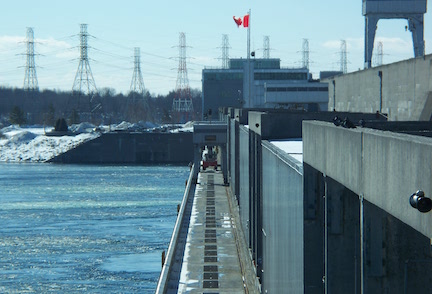The following is text of a news release from the Chamber of Marine Commerce:
(OTTAWA) — Marine shipping executives are calling on government officials to protect the St. Lawrence Seaway trade corridor by working with stakeholders to develop solutions that do not rely on one ineffective dam to solve high-water levels across the Great Lakes.
The opening of the navigation season in the Montreal-Lake Ontario (MLO) section of the St. Lawrence Seaway has been delayed to April 1 to allow more outflow from Moses-Saunders Power Dam to lower Lake Ontario water levels. The Welland Canal will open March 24.
With little ice coverage, the MLO section of the St. Lawrence Seaway could have opened as early as March 20. As many as 100 ship transits could have occurred during that 12 days.
“We’re very disappointed with this delay. It’s time for politicians to start working with all the affected residents, businesses and shipping stakeholders on smart, effective solutions for high water levels," said Bruce Burrows, president of the Chamber of Marine Commerce. "Delaying, shutting down or interrupting American, Canadian and international trade on the St. Lawrence Seaway and further damaging the economy and our nations’ global trading reputation should never be an option. This dam is a very limited tool that does not solve this problem. We need to work together to develop a much broader, holistic resiliency plan that looks at every avenue including flood zoning, shoreline resiliency and infrastructure investments.”
Evidence from the International Lake Ontario-St. Lawrence River Board (ILORB) demonstrates that outflow levels at Moses-Saunders Dam have little impact on the problem, lowering the lake by centimeters only to have more water come flooding in from precipitation or Lake Erie and the other overflowing Great Lakes. With every outflow decision, the ILORB has to consider downstream flooding in Montreal, upstream municipal water intakes, power generation, shoreline damage and navigation safety for both commercial and recreational interests.
In 2019, marine shipping worked diligently with stakeholders to ensure safe navigation at record outflow levels from Moses-Saunders Dam on the St. Lawrence Seaway for five months to help lower Lake Ontario, taking on 26 mitigation measures that caused shipping delays, lost cargo business and millions of dollars of extra operating costs. The marine shipping industry is working with officials across both sides of the border to study what improvements can be made that could lead to navigation during increased outflow periods if water causes flooding on Lake Ontario in 2020.
But water levels have continuously led to calls by shoreline residents to “open the floodgates” at the dam. This move would create fast-moving, unsafe currents that would stop marine shipping and cost the Canadian and American economies up to $193 million (U.S.) in lost business revenues a week – impacting farmers, steel and manufacturing employees, miners and construction workers and the myriad of others whose livelihoods depend on the cargo carried on the waterway.
“It’s important to understand that ships delivering and shipping goods from Great Lakes ports like the Port of Toledo, Ohio, are part of a supply chain linking the Midwest to global markets," said Thomas Winston, president and CEO of the Toledo-Lucas County Port Authority. "A disruption in the supply chain would have considerable ripple effect in the many industries we serve including U.S. steel production, aggregates for construction, energy generation, and agricultural exports. Often there are no alternative routes to deliver these commodities."
“The high water levels throughout the system are concerning for all involved, from perspectives of navigability, property damage, and economic and community resiliency," said Deb DeLuca, executive director of the Duluth Seaway Port Authority. "As agencies move forward in deciding how to best manage water levels, it’s important that they protect the operability and reputation of the Great Lakes-St. Lawrence Seaway maritime trade corridor and the significant economic benefit it provides to communities throughout the region in both the United States and Canada. In the world of freight, reliability and efficiency are key performance metrics. Delayed shipments and uncertain system availability will result in lost business that may not return. Shippers would seek alternative supply routes and supply chains, potentially resulting in permanent traffic loss for U.S. and Canadian ports, an outcome that would cause substantial, far-reaching and long-term damage to the entire Great Lakes region.”
"LafargeHolcim supports increasing water outflow levels on the St. Lawrence Seaway as long as it is safe for ships to operate," said Chuck Hriczak, marine operations manager, Great Lakes and East Coast, for LafargeHolcim U.S. "We partner with and trust our vessel partners to put safety above all else, but raising water outflows to levels that would force navigation stoppages or cut the season short would be detrimental to our business. LafargeHolcim relies on Seaway shipping to bring raw materials in from overseas for cement production – materials not available in the U.S. or Canada. Seaway shipping is also the most cost efficient and environmentally sound way for us to transport large volumes of construction materials which are used to build everything from buildings to roads, bridges and airport runways. LafargeHolcim depends on having reliable, uninterrupted transportation on the St. Lawrence Seaway to produce products that serve our customers, which are ultimately people living and working in the Great Lakes-St. Lawrence region."

